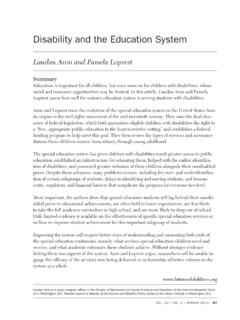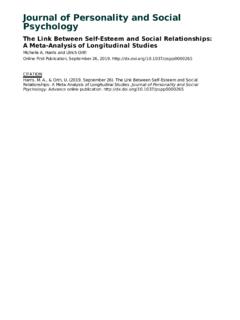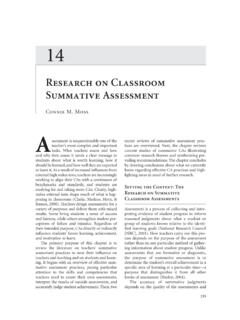Transcription of Chapter 4 - Factors That Influence Tobacco Use
1 Chapter 4 Factors that Influence Tobacco Use Among Four Racial/Ethnic Minority Groups Introduction 207 Historical Context of Tobacco 208 African Americans 208 American Indians and Alaska Natives 209 Asian Americans and Pacific Islanders 211 Hispanics 212 Economic Influences 213 Tobacco Industry Support for Racial/Ethnic Minority Communities 213 Employment Opportunities 213 Advertising Revenues 214 Funding of Community Agencies and Organizations 215 Support for Education 217 Support for Political, Civic, and Community Campaigns 217 Support for Cultural Activities 218 Support for Sports Events 219 Advertising and Promotion 220 Magazine Advertisements 221 Outdoor Advertisements 221 In-Store Promotions 222 Racial/Ethnic Symbols, Names, and Events 222 Targeted Products 223 Psychosocial Determinants 225 Initiation and Early Use of Tobacco 225 African Americans 226 American Indians and Alaska Natives 227 Asian Americans and Pacific Islanders 227 Hispanics 228 Multiple Group Studies 229 Prevalence of Risk Factors for Cigarette Use 229 Factors Associated with Initiation of Cigarette Use 231 Factors Associated with Initiation of Smokeless Tobacco Use 232 Summary, Initiation and Early Use of Tobacco 233 Tobacco Use Among Adults 233 African Americans 233 American Indians and Alaska Natives 233 Asian Americans and Pacific Islanders 234 Hispanics 234 Summary, Tobacco Use Among Adults 235 Smoking Cessation 235 African Americans 235 American Indians and Alaska Natives 237 Asian Americans and Pacific Islanders 237 Hispanics 237 Summary, Smoking Cessation 237 Methodological Limitations of the Literature 238 Chapter Summary 239 Conclusions 240 Appendix.
2 A Brief History of Tobacco Advertising Targeting African Americans 240 Early Assumptions 240 Early Targeted Advertising Efforts (1940s 1960s) 241 Recent Targeted Advertising Efforts (Late 1960s 1980s) 243 References 245 Tobacco Use Among Racial/Ethnic Minority Groups Introduction Tobacco use is determined and influenced by several kinds of Factors : (1) individual Factors (per ceptions, self-image, peers); (2) social Factors (societal norms); (3) environmental Factors , such as advertising and economics; and (4) cultural Factors , such as traditional uses of Tobacco , acculturation, and the historical context of the Tobacco industry in various communities. Behavior and patterns of Tobacco use result from each of these Factors and from their com plex interplay, which is difficult to study and measure. Although available evidence has demonstrated that these Factors contribute to behavior, research has been unable to quantify the distinct effect of each one and the effects of their interaction.
3 The lack of definitive literature points to the need for further research to bet ter quantify the ways in which a person s exposure to various social, environmental, and cultural influences affects Tobacco use behavior. Most likely, it is not a single factor but rather the convergence or interaction of some or all of these Factors that significantly influ ences both a person s decision to use Tobacco and pat terns of Tobacco use ( Department of Health and Human Services [USDHHS] 1989; Lynch and Bonnie 1994; USDHHS 1994). This Chapter examines the com plex Factors that Influence Tobacco use among the four major racial/ethnic minority groups. Tobacco has a role in all communities through social, economic, and cultural connections. These con nections include (1) social customs, such as the shar ing and giving of Tobacco in Asian communities; (2) employment opportunities and economic growth provided to racial/ethnic groups through Tobacco agriculture and manufacturing; (3) Tobacco industry support of community leaders and organizations; (4) Tobacco industry sponsorship of cultural events; and (5) ceremonial and medicinal uses of Tobacco .
4 Indeed, Tobacco s history has led to some positive social perceptions of Tobacco , perceptions that may also Influence use. Cigarette advertising and promotion may stimu late cigarette consumption by (1) encouraging children and adolescents to experiment with and initiate regu lar Tobacco use, (2) deterring current Tobacco users from quitting, (3) prompting former users to begin using again, and (4) increasing daily consumption by serv ing as an external cue to smoke (Centers for Disease Control [CDC] 1990a). Whether or not they are intended to do so, advertising and promotional activi ties appear to Influence risk Factors for adolescent Tobacco use (USDHHS 1994). Cigarette advertising appears to affect young people s perceptions of the per vasiveness, image, and function of smoking. Because misperceptions in these areas constitute psychosocial risk Factors for the initiation of smoking, cigarette ad vertising appears to increase young people s risk of smoking.
5 The Food and Drug Administration (FDA) recently concluded that although advertising may not be the most important factor in a child s decision to smoke, studies establish that it is a substantial con tributing factor (Federal Register 1996). A different kind of Influence is found in psycho social variables, which help explain why people start using Tobacco , why some continue using it, and why some stop using it. Published research findings are scant about individual and interpersonal Factors that Influence Tobacco use among African Americans, American Indians, Alaska Natives, Asian Americans, Pacific Islanders, and Hispanics. This paucity of data, in fact, both inspired and hampered the development of this report. Although research findings based on samples of the majority white population may be applicable to racial/ethnic populations, such generalizability has not been sufficiently studied. Furthermore, cultural differences exist among commu nities and members of various racial/ethnic groups in values, norms, expectancies, attitudes, and the histori cal context of Tobacco and the Tobacco industry.
6 Such differences, in turn, may Influence both the prevalence of cigarette smoking in a particular racial/ethnic mi nority group and the effect of certain associated risk Factors (Mar n et al. 1990a; Vander Martin et al. 1990; Robinson et al. 1992a). Another important factor that may Influence to bacco use behavior is the actual infrastructure within a community for conducting Tobacco control activities that support a non- Tobacco -use norm. This capacity of the community for Tobacco control activities is also discussed in Chapter 5 of this report because it directly affects such programs, in addition to the Influence it may have on the environmental context of Tobacco use. The first part of this Chapter summarizes the his tory of Tobacco use among members of the four major racial/ethnic groups in the United States African Americans, American Indians and Alaska Natives, Asian Americans and Pacific Islanders, and Hispan ics. The association between the Tobacco industry and these communities, including economic influences and the role of targeted advertising and promotion, is also Factors that Influence Tobacco Use 207 Surgeon General s Report described.
7 The second part of the Chapter discusses psychosocial influences associated with initiation of Tobacco use, maintenance, and cessation among the four groups. Unfortunately, the limited information available affects the length and comprehensiveness of the presentation. The appendix presents a short his-Historical Context of Tobacco tory of Tobacco advertising targeting African Ameri cans. Because so little information is available on the history of cigarette advertising aimed at American In dians, Alaska Natives, Asian Americans, Pacific Island ers, and Hispanics, these groups are not discussed in the appendix. African Americans The first recorded landing of Africans in the United States was in 1619, when a group of indentured servants was brought to Jamestown, Virginia (Foner 1981), and Jamestown quickly became the center for profitable Tobacco trade with England and other Eu ropean nations (USDHHS 1992). Indeed, a significant portion of the early colonies wealth derived from the exportation of Tobacco (Northrup and Ash 1970).
8 Cot ton did not become preeminent until the invention of the cotton gin in 1793 (Foner 1981). Tobacco farming was widespread throughout the south, and although Tobacco was later supplanted by other crops (includ ing cotton) in many areas, it remains a major crop in six states Georgia, Kentucky, North Carolina, South Carolina, Tennessee, and Virginia (Gale 1993). Whites initially were employed in Tobacco culti vation, but as Tobacco prices fell in Europe, Tobacco companies began using less expensive labor (Kulikoff 1986). Among other Factors , the need for a larger and less expensive labor force to grow Tobacco led the colo nies to gradually transform the status of Africans from indentured servants, who earned their freedom after a period of involuntary servitude, to slaves, who were the property of their masters for life. In addition to slaves, many free African Americans worked in to bacco farming during the 18th and 19th centuries. In deed, more free African Americans were employed in Tobacco production than in any other occupational category in the south during that time (Northrup and Ash 1970).
9 Slaves also hired themselves out as Tobacco laborers, and some earned enough funds to purchase their freedom. After emancipation, freed African Americans who had obtained some acreage began farming to bacco because it was a cash crop that did not require much land to be profitable. In particular, freed African Americans farmed Tobacco in Georgia, North Carolina, South Carolina, and Virginia. Nevertheless, the number of Tobacco farms owned by African Ameri cans has declined dramatically in the 20th century, pos sibly because so many African Americans, including Tobacco farm owners and laborers, were migrating to the north ( Commission on Civil Rights 1982; Gale 1993). In the colonial period and early years of the United States, African Americans and whites worked side by side in cigarette-manufacturing factories, which tended to be primarily small cottage industries. However, the introduction of the cigarette-making machine in the mid-1880s changed this pattern.
10 Be cause white women were viewed as the only group that had the manual dexterity needed to operate the machines, and it was socially unacceptable for Afri can American men and women to work alongside white women, African Americans were replaced as factory workers and relegated to less skilled, menial, field jobs (Northrup and Ash 1970; Meyer 1992). Dur ing the early 1900s, the dirtiest, unhealthiest, and low est paying jobs in Tobacco factories were carried out by African American women (Jones 1984). Because the jobs held by African Americans in stemming and processing the Tobacco leaf were low paying, the to bacco industry made little effort to mechanize such jobs before the early 1930s. Thus, many African Americans remained employed in the Tobacco industry, even as Tobacco factories began replacing people with labor saving machines (Northrup and Ash 1970). The high concentration of African Americans in certain occupations helped them gain a foothold in one of the few areas in which organized labor had achieved success in the south.















